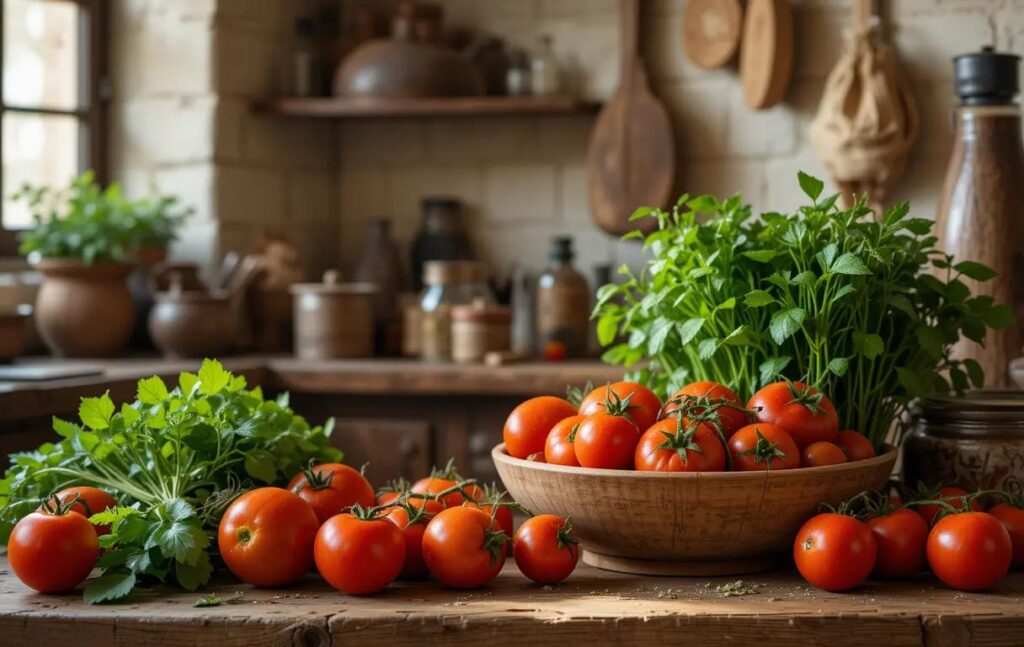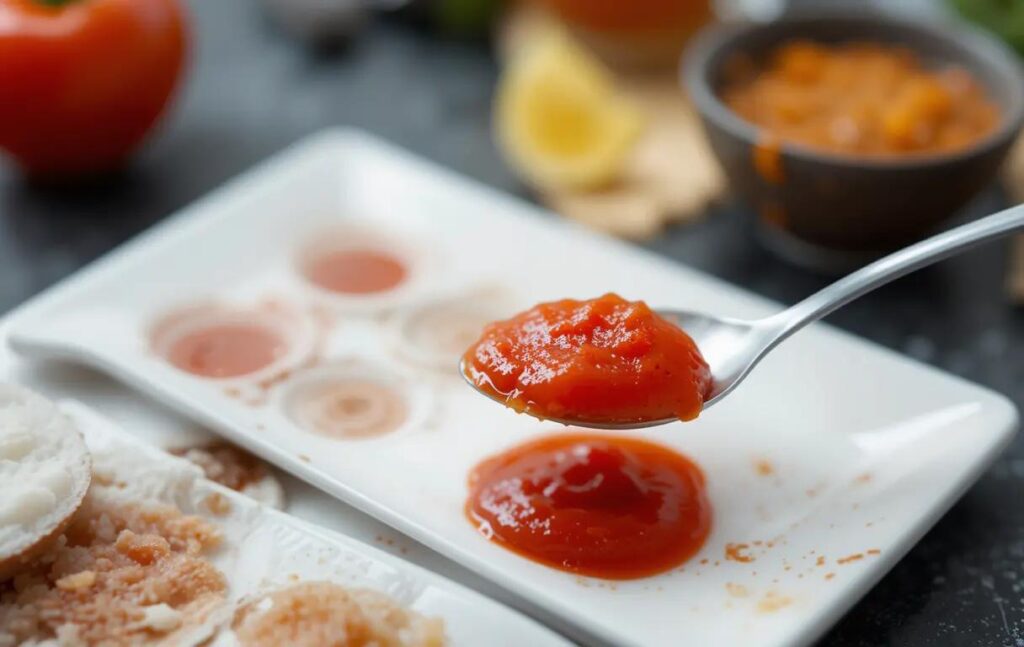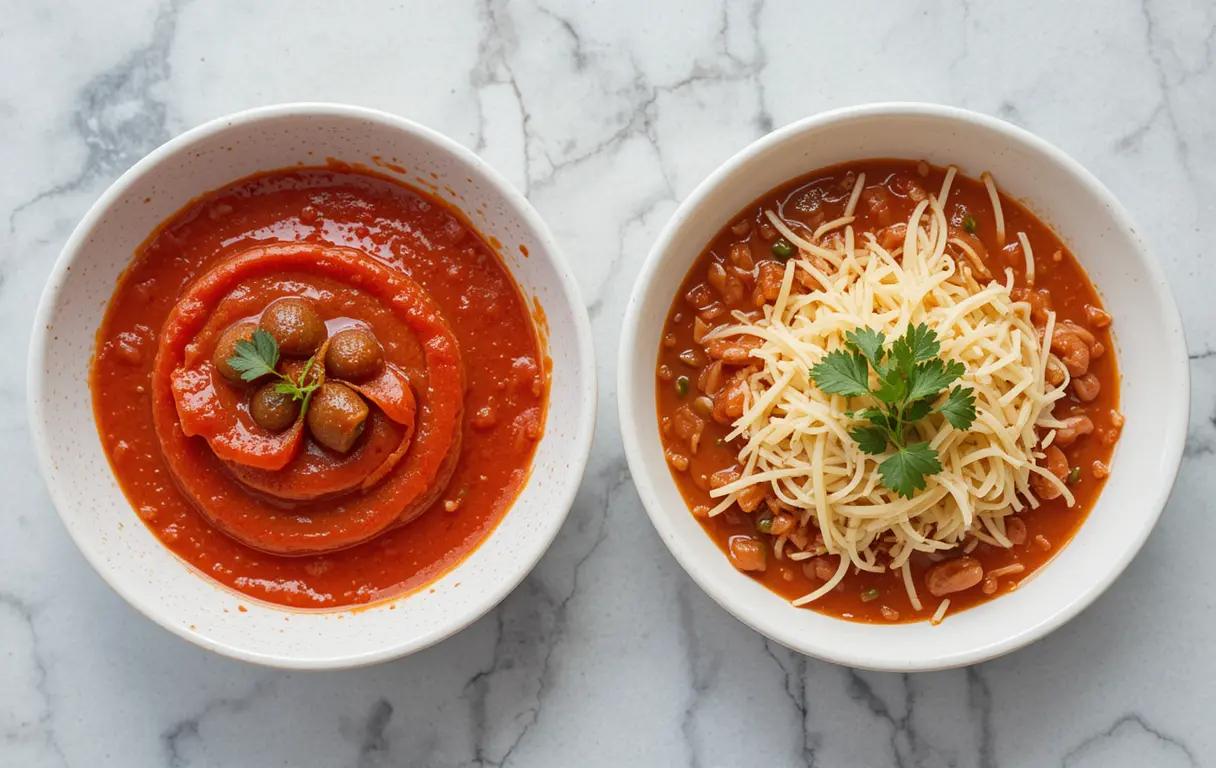What’s the Difference Between Tomato Sauce and Tomato Gravy?
Tomatoes are one of the most versatile ingredients in cooking, serving as the foundation for countless sauces, soups, and stews. Among the most popular creations are tomato sauce and tomato gravy. While the terms might sound interchangeable, they are far from identical. The distinctions lie in their origins, ingredients, preparation methods, and even their culinary applications.
This article will dive deep into these differences to uncover the essence of each, helping you decide whether to serve tomato sauce or tomato gravy at your next meal. By understanding these distinctions, you’ll gain insights into their flavors, cultural significance, and how to best incorporate them into your dishes.
What You’ll Learn in This Article
- A detailed definition of tomato sauce and tomato gravy
- Their key differences in ingredients and preparation
- Historical and cultural influences that shaped each
- Unique uses and pairings for both in cooking
- Answers to common misconceptions and frequently asked questions
Why It Matters
Understanding the difference between tomato sauce and tomato gravy goes beyond semantics. It’s about appreciating the culinary artistry behind each recipe and how they contribute to diverse gastronomic traditions. Whether you’re a food enthusiast, a home chef, or just curious, this knowledge enhances your appreciation of global cuisines.
Understanding the Basics
What Is Tomato Sauce?
Tomato sauce is a staple of Italian and Mediterranean cooking, typically made from tomatoes that are cooked and seasoned to create a rich, flavorful base. Its simplicity and versatility make it a key ingredient in a wide variety of dishes, from pasta to pizzas and beyond.
Key Characteristics of Tomato Sauce:
- Main Ingredients: Tomato sauce is traditionally prepared with ripe tomatoes, garlic, onions, olive oil, and seasonings like basil, oregano, and parsley.
- Texture and Consistency: Smooth and moderately thick, making it ideal for coating pasta or serving as a base for stews.
- Flavor Profile: Tomato-forward with a balance of sweetness and acidity, often enriched by herbs and aromatics.
- Primary Uses: As a sauce for pasta, pizza topping, or a foundation for other sauces like marinara or arrabbiata.
A Quick Fact:
The origins of tomato sauce trace back to the 16th century, when tomatoes, introduced to Europe from the Americas, became a beloved ingredient in Italian cuisine.
What Is Tomato Gravy?
Tomato gravy, on the other hand, is deeply rooted in Southern American cooking. It is a savory sauce typically prepared with a tomato base but often enriched with meat drippings or stock for a heartier, more robust flavor.
Key Characteristics of Tomato Gravy:
- Main Ingredients: Tomatoes or canned tomato products, meat drippings (from bacon, sausage, or roast meats), and a thickening agent like flour.
- Texture and Consistency: Slightly thicker than tomato sauce, with a more rustic, chunky texture in some recipes.
- Flavor Profile: Rich, savory, and smoky, often enhanced by the addition of meat or fat.
- Primary Uses: As a topping for biscuits, rice, or grits, or as a hearty accompaniment to Southern comfort foods.
A Quick Fact:
Tomato gravy reflects the ingenuity of Southern cooks, who transformed simple ingredients like tomatoes and leftover meat drippings into a flavorful, filling addition to everyday meals.
Visualizing the Difference
Imagine two pots on the stove. One contains a smooth, aromatic tomato sauce simmering with herbs, perfect for tossing with spaghetti. The other holds a rich, savory tomato gravy, thickened with a touch of flour and flecked with bits of bacon, ready to be poured over a stack of warm biscuits.
These two preparations represent distinct culinary traditions and purposes, each offering its own delightful experience.
Key Differences in Ingredients
Tomato Sauce Ingredients
The ingredients in tomato sauce are carefully selected to highlight the natural sweetness and acidity of tomatoes while adding depth through herbs and aromatics. Here’s what typically goes into this classic sauce:
Essential Ingredients:
- Tomatoes: Fresh, canned, or even pureed tomatoes serve as the base. San Marzano tomatoes, known for their sweetness and low acidity, are often preferred.
- Garlic and Onions: Sautéed in olive oil, these add a subtle, aromatic undertone.
- Olive Oil: Used to sauté aromatics and give the sauce a silky texture.
- Herbs: Basil, oregano, and parsley bring a fresh, herbaceous quality.
- Seasoning: Salt, pepper, and occasionally a pinch of sugar to balance the acidity of the tomatoes.
Optional Additions:
- Wine: Red or white wine can be used to enhance the depth of flavor.
- Vegetables: Some variations include carrots or celery for additional sweetness.
The emphasis in tomato sauce is on simplicity, allowing the tomato’s flavor to shine.
Tomato Gravy Ingredients
Tomato gravy, in contrast, is a richer, more indulgent creation. Its ingredient list reflects its origins in Southern comfort food, emphasizing heartiness and savory flavors.
Essential Ingredients:
- Tomatoes or Tomato Products: Often canned tomatoes, such as crushed or diced, provide the base.
- Meat Drippings or Fat: Rendered bacon grease, sausage drippings, or butter adds depth and richness.
- Flour: Used as a thickening agent, giving the gravy its characteristic texture.
- Stock or Broth: Chicken, beef, or vegetable stock enhances the savory profile.
Optional Additions:
- Meat: Small pieces of bacon or sausage are sometimes left in the gravy for extra flavor.
- Onions and Peppers: These can be added for a slightly chunky texture and enhanced flavor.
- Spices: Paprika, cayenne, or even a dash of hot sauce adds a touch of heat.
Tomato gravy prioritizes richness and heartiness, making it a perfect topping for starchy comfort foods.
Comparison of Key Ingredients
| Ingredient | Tomato Sauce | Tomato Gravy |
|---|---|---|
| Base | Fresh or canned tomatoes | Canned tomatoes or tomato paste |
| Fats | Olive oil | Meat drippings, butter, or lard |
| Thickener | None | Flour |
| Additional Flavors | Herbs (basil, oregano) | Meat, onions, peppers |
| Texture | Smooth to slightly chunky | Thick, often rustic |
Why Ingredients Matter
The ingredients define the identity and purpose of each preparation. Tomato sauce is versatile and light, suitable for a wide range of Italian and Mediterranean dishes. Tomato gravy, however, is richer and heartier, perfectly complementing Southern staples like biscuits and grits.
Culinary Origins and Regional Variations

Italian Roots of Tomato Sauce
Tomato sauce has its roots firmly planted in Italian cuisine, where it is considered a cornerstone of many dishes. Its history dates back to the 16th century when tomatoes, brought to Europe from the Americas, began appearing in Italian kitchens. Over time, tomato sauce evolved into a versatile base used in countless recipes.
Key Historical Insights:
- Origins: The first recorded recipe for tomato sauce appeared in Antonio Latini’s cookbook, Lo Scalco alla Moderna (The Modern Steward), in the late 17th century.
- Evolution: As Italian cuisine spread globally, tomato sauce became synonymous with Italian-American dishes like spaghetti and meatballs or lasagna.
- Regional Variations: In Italy, tomato sauce varies by region:
- Southern Italy: Uses fresh tomatoes, garlic, and olive oil, resulting in a light and tangy sauce.
- Northern Italy: Incorporates butter and cream for a richer, smoother texture.
Tomato sauce’s adaptability and universal appeal have made it a culinary classic worldwide.
Southern Influence in Tomato Gravy
Tomato gravy, in contrast, emerged from the traditions of Southern American cooking. This dish reflects the ingenuity of home cooks who used simple, accessible ingredients to create a comforting, hearty sauce.
Key Historical Insights:
- Origins: Tomato gravy likely developed during the 19th century in the rural South, where cooks often used tomatoes and leftover meat drippings to create flavorful sauces.
- Cultural Context: The dish became a staple of Southern cuisine, served over biscuits, rice, or grits as a cost-effective way to enhance meals.
- Regional Variations: While tomato gravy is primarily associated with the South, its preparation differs slightly:
- Deep South: Emphasizes bacon or sausage drippings for a smoky flavor.
- Appalachian Region: May include sweeter notes with onions or a touch of sugar.
Tomato gravy embodies Southern comfort food—rich, savory, and perfect for hearty meals.
A Cross-Cultural Comparison
| Aspect | Tomato Sauce | Tomato Gravy |
|---|---|---|
| Origin | Italy | Southern United States |
| Primary Use | Pasta, pizza, and stews | Biscuits, rice, grits |
| Cultural Significance | A symbol of Italian tradition | A staple of Southern comfort food |
| Flavor Influence | Fresh, herbaceous, and light | Rich, savory, and smoky |
Global Influence
While tomato sauce has become a global phenomenon, tomato gravy remains a regional specialty. However, both preparations reflect their respective cultures’ ingenuity in making the most of simple ingredients.
Cooking Techniques and Culinary Uses
How Tomato Sauce is Made
Making tomato sauce is a straightforward yet deeply rewarding process. The goal is to enhance the natural flavors of tomatoes while creating a smooth, flavorful base for various dishes. Here’s a step-by-step guide:
Ingredients:
- Tomatoes (fresh or canned)
- Olive oil
- Garlic and onions
- Herbs (basil, oregano, parsley)
- Salt, pepper, and optional sugar
Steps to Prepare Tomato Sauce:
- Sauté Aromatics: Heat olive oil in a saucepan and sauté garlic and onions until fragrant.
- Add Tomatoes: Incorporate fresh, diced, or canned tomatoes. Simmer gently to break them down.
- Season and Simmer: Add herbs and seasoning, then simmer for 30–45 minutes, stirring occasionally.
- Blend (Optional): For a smooth sauce, use an immersion blender or food processor.
- Adjust Consistency: Add water or stock if the sauce is too thick.
This versatile sauce can be used immediately or stored for later.
Common Culinary Uses for Tomato Sauce:
- Tossed with pasta for a classic spaghetti dish.
- Spread over pizza dough as a flavorful base.
- Incorporated into stews and braises for added depth.
- Used as a dipping sauce for appetizers like mozzarella sticks.
How Tomato Gravy is Made
Tomato gravy, with its rich and savory profile, requires a slightly different approach, emphasizing fat and flour to create a hearty consistency.
Ingredients:
- Canned tomatoes or tomato paste
- Meat drippings (bacon, sausage, or roast)
- All-purpose flour
- Chicken or beef stock
- Salt, pepper, and optional spices (paprika or cayenne)
Steps to Prepare Tomato Gravy:
- Cook the Fat: In a skillet, heat meat drippings until melted.
- Make a Roux: Add flour to the fat and stir until golden brown, creating a roux.
- Add Tomatoes and Stock: Mix in tomatoes and gradually whisk in stock, ensuring no lumps.
- Season and Simmer: Add salt, pepper, and spices, then simmer until thickened.
- Serve: Pour over biscuits, rice, or grits for a comforting meal.
Common Culinary Uses for Tomato Gravy:
- Served over fluffy biscuits as a hearty breakfast.
- Paired with rice or grits as a savory side.
- Used as a topping for meatloaf or pork chops.
Comparison of Cooking Techniques
| Aspect | Tomato Sauce | Tomato Gravy |
|---|---|---|
| Cooking Base | Olive oil and tomatoes | Meat drippings and tomatoes |
| Thickening Agent | None or natural reduction | Roux (flour and fat) |
| Cooking Time | 30–45 minutes | 20–30 minutes |
| Texture | Smooth or slightly chunky | Thick, hearty, and sometimes rustic |
Unique Applications
The differences in preparation lead to unique culinary uses:
- Tomato Sauce: Elevates Italian and Mediterranean dishes with its fresh, herbaceous flavor.
- Tomato Gravy: Enhances Southern comfort foods with its rich, savory profile.
Why These Differences Matter
The cooking techniques for tomato sauce and tomato gravy reflect their cultural roots and culinary purposes. Tomato sauce’s smooth, versatile nature complements pasta and pizza, while tomato gravy’s heartiness makes it a staple in Southern kitchens.
Taste and Texture Profiles

Tomato Sauce: Flavor and Texture
Tomato sauce is celebrated for its light, fresh, and herbaceous qualities. Its flavor and texture are the result of a careful balance between natural tomato sweetness, acidity, and the aromatic depth of herbs and garlic.
Key Flavor Characteristics:
- Sweetness and Acidity: The natural sweetness of ripe tomatoes is balanced by their tangy acidity, creating a vibrant base.
- Herbaceous Notes: Basil, oregano, and parsley add layers of flavor, ranging from sweet to slightly peppery.
- Savory Undertones: Garlic and onions lend a subtle savory richness.
Texture:
- Smooth or Chunky: Tomato sauce can be pureed for a silky consistency or left slightly chunky for a more rustic appeal.
- Light and Fluid: Perfect for coating pasta evenly without overpowering the dish.
Best Pairings:
Tomato sauce is best suited to Italian and Mediterranean dishes, enhancing everything from spaghetti to chicken Parmesan with its balanced, versatile taste.
Tomato Gravy: Flavor and Texture
Tomato gravy, by contrast, is rich, hearty, and deeply savory. Its flavor profile is heavily influenced by the addition of meat drippings and flour, which create a robust and satisfying sauce.
Key Flavor Characteristics:
- Smoky and Savory: Bacon or sausage drippings infuse the sauce with a smoky depth.
- Umami-Rich: Meat or stock adds a savory umami punch that makes the gravy hearty and satisfying.
- Optional Heat or Spice: Spices like paprika or cayenne provide a subtle kick in some variations.
Texture:
- Thick and Hearty: Tomato gravy’s consistency is heavier, designed to cling to biscuits, rice, or grits.
- Rustic and Chunky: Depending on preparation, it may have visible bits of tomatoes, onions, or meat.
Best Pairings:
Tomato gravy shines as a topping for comfort foods like biscuits, cornbread, or pork chops. It’s a staple at Southern tables, offering a nostalgic taste of home-cooked meals.
Flavor and Texture Comparison
| Aspect | Tomato Sauce | Tomato Gravy |
|---|---|---|
| Flavor Profile | Sweet, tangy, and herbaceous | Smoky, savory, and rich |
| Key Influences | Herbs and fresh tomatoes | Meat drippings and flour |
| Texture | Light, smooth, or slightly chunky | Thick, hearty, and sometimes rustic |
| Best Uses | Pasta, pizza, and Mediterranean dishes | Biscuits, grits, rice, and Southern comfort foods |
Why These Differences Matter
The taste and texture of these sauces dictate their applications in cooking. Tomato sauce’s light and fresh qualities make it a universal base for Italian and Mediterranean cuisine, while tomato gravy’s hearty, savory profile defines it as a Southern comfort food essential.
FAQs: Tomato Sauce vs. Tomato Gravy
1. Why do some people call it tomato gravy?
In the South, the term “gravy” often refers to any sauce thickened with fat and flour. The name reflects the dish’s savory, rich preparation using meat drippings.
2. Can tomato gravy be vegetarian?
Yes, tomato gravy can be made vegetarian by substituting butter or plant-based fat for meat drippings and using vegetable stock instead of chicken or beef stock.
3. Which is more versatile: tomato sauce or tomato gravy?
Tomato sauce is more versatile due to its lighter flavor and wider range of applications, from pasta to pizza. Tomato gravy is more specialized, ideal for pairing with Southern dishes.
4. Are tomato sauce and tomato gravy interchangeable?
No, the two are not interchangeable. Tomato sauce’s lightness contrasts with tomato gravy’s heaviness, making them suited to different dishes.
5. Is tomato gravy a Southern version of tomato sauce?
Not exactly. While both share a tomato base, tomato gravy’s use of meat drippings and thickening agents sets it apart as a uniquely Southern creation.
Conclusion: Celebrating the Diversity of Tomato-Based Sauces
Tomato sauce and tomato gravy may start with the same key ingredient, but their preparation, flavor, and applications set them worlds apart. Tomato sauce, with its Italian origins, offers a light, herbaceous complement to pasta and Mediterranean dishes. Meanwhile, tomato gravy, a Southern staple, provides a rich, hearty addition to comfort foods like biscuits and grits.
Understanding their differences helps us appreciate the cultural significance and culinary artistry behind each. Whether you’re whipping up a classic marinara or ladling tomato gravy over warm biscuits, both sauces showcase the incredible versatility of tomatoes in the kitchen.
Tomato Sauce
Related Recipes
- “Tuna Tomato Sauce Pasta Recipe“: A tomato-based recipe showcasing another way to use tomatoes.
- “Baked Chicken Fettuccine Alfredo with Broccoli“: Another comforting dish that can be complemented with tomato-based sauces.
Ingredient-Focused Content
- “Lions Mane Mushroom Recipe“: Suggest using a tomato gravy as a flavorful addition for plant-based dishes.
Cooking Techniques and Enhancements
- “Mango Habanero Salsa“: Explore complementary uses of sauces and gravies for flavor diversity.
Storage and Reuse Tips
- “Sous Vide Recipes“: Recommend tomato gravy as a sauce for sous vide-cooked meats or vegetables.
- “Ocean Spray Cranberry Sauce Recipe“: Guide readers on making and storing sauces, including tomato gravy.

